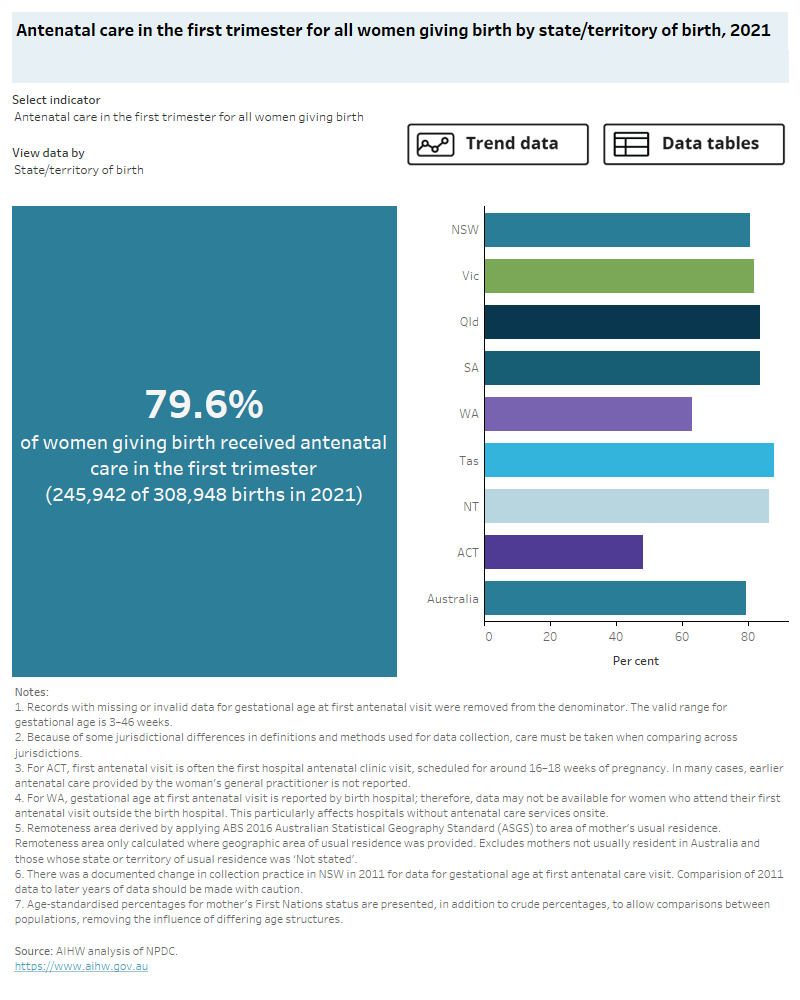Antenatal care in the first trimester
Antenatal care is a planned visit between a pregnant woman and a midwife or doctor to assess and improve the wellbeing of the mother and baby throughout pregnancy. Antenatal care is associated with positive maternal and child health outcomes. The likelihood of receiving effective health interventions is increased through attending antenatal care. For more information, see Clinical commentary.
This indicator examines antenatal care visits in the first trimester (before 14 weeks gestational age) and in the first 10 weeks for all women giving birth. It does not include visits where the sole purpose is to confirm the pregnancy.
Key findings
- Around 4 in 5 women (80%) giving birth in 2021 had an antenatal care visit in their first trimester and around 3 in 5 (61%) had an antenatal care visit within the first 10 weeks of pregnancy.
- The proportion of women having an antenatal care visit in the first trimester of pregnancy and in the first 10 weeks of pregnancy have both increased over time (from 66% in 2011 to 80% in 2021, and 38% in 2011 to 61% in 2021, respectively).
The proportion of women who had an antenatal care visit in the first trimester of pregnancy:
- was higher for women in their 30s (around 81% in 2021) compared to those younger than 20 (68% in 2021)
- was higher for women living in Major cities (79%), Inner regional (83%), or Outer regional (81%) areas than those living in Remote (73%) or Very remote (68%) areas in 2021
- was lower for women living in areas of most disadvantage (77% in 2021) compared with other areas.
The interactive data visualisation (Figure 5) presents data on antenatal care for all women giving birth in the first 10 weeks of pregnancy and in the first trimester by selected maternal characteristics. Select the trend button to see how data have changed between 2011 and 2021.
Figure 5: Antenatal care in the first trimester
Antenatal care in the first trimester for all women giving birth, 2011 to 2021.
This chart shows the proportion of women giving birth who received antenatal care in the first trimester (before 14 weeks gestation), for the current data 2021 and trend data from 2011 to 2021. The proportion for all Australian mothers increased from 66% in 2011 to 80% in 2021.
The chart also shows the proportion of women giving birth who had their first antenatal visit within the first 10 weeks of pregnancy. The proportion has increased from 38% in 2011 to 61% in 2021.

Clinical commentary
Antenatal care is a system of regular assessments by a midwife or doctor throughout the course of the pregnancy that provides the opportunity to promote healthy lifestyles, screen for and – if necessary – treat health problems to benefit both mother and baby (WHO 2016). Commencing regular antenatal care in the first trimester (before 14 weeks of gestation) is associated with better maternal health in pregnancy, fewer interventions in late pregnancy and positive child health outcomes (AIHW 2023; DoH 2020). The Australian Pregnancy Care Guidelines (DoH 2020) recommend that a woman has her first antenatal visit within the first 10 weeks of pregnancy.
The first contact with a woman in the antenatal period may be when she attends primary care, usually a general practitioner (GP), to confirm the pregnancy. Women will either start antenatal care at that point or be referred to a maternity care provider or service; for example, a midwife, obstetrician, GP, or Aboriginal health service (DoH 2020).
Indicator specifications and data
Excel source data tables are available from Data.
For more information refer to Specifications and notes for analysis in the technical notes.
AIHW (Australian Institute of Health and Welfare) (2023) Australia’s mothers and babies, AIHW, Australian Government, accessed 29 June 2023.
DoH (Department of Health) (2020) Clinical Practice Guidelines: Pregnancy Care 2020 Edition, Department of Health, Australian Government, accessed 20 March 2023.
WHO (World Health Organization) (2016) WHO recommendations on antenatal care for a positive pregnancy experience, WHO, Geneva, accessed 23 April 2021.


